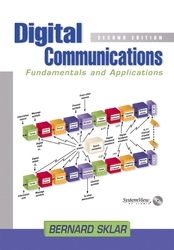Digital Signal Processing: A Practitioner's Approach
暫譯: 數位信號處理:實務者的方式
Kaluri V. Rangarao, Ranjan K. Mallik
- 出版商: Wiley
- 出版日期: 2006-01-01
- 定價: $3,980
- 售價: 8.5 折 $3,383
- 語言: 英文
- 頁數: 191
- 裝訂: Hardcover
- ISBN: 0470017694
- ISBN-13: 9780470017692
-
相關分類:
數位訊號處理 Dsp
立即出貨 (庫存=1)
買這商品的人也買了...
-
 編譯程式原理、技巧與工具(上冊) (Compilers: Principles, Techniques, and Tools)
編譯程式原理、技巧與工具(上冊) (Compilers: Principles, Techniques, and Tools)$380$300 -
 C++ Builder 6 程式設計快樂上手
C++ Builder 6 程式設計快樂上手$590$590 -
 Assembly Language for Intel-Based Computers, 4/e (平裝版)
Assembly Language for Intel-Based Computers, 4/e (平裝版)$960$941 -
 資料庫系統之理論與實務
資料庫系統之理論與實務$680$646 -
 Microsoft Office Access 2003 Step by Step
Microsoft Office Access 2003 Step by Step$1,130$1,074 -
 資料探礦概念與技術(Data Mining: Concepts and Techniques)
資料探礦概念與技術(Data Mining: Concepts and Techniques)$800$720 -
 建構嵌入式 Linux 系統
建構嵌入式 Linux 系統$780$616 -
 藍芽技術理論與實作
藍芽技術理論與實作$380$300 -
 計算機組織與設計 (Computer Organization and Design: The Hardware/Software Interface, 3/e)
計算機組織與設計 (Computer Organization and Design: The Hardware/Software Interface, 3/e)$680$646 -
 新一代 ASP.NET 2.0 網站開發實戰-使用C# 以及 VB
新一代 ASP.NET 2.0 網站開發實戰-使用C# 以及 VB$550$468 -
 Linux 核心開發指南 (Linux Kernel Development, 2/e)
Linux 核心開發指南 (Linux Kernel Development, 2/e)$550$495 -
 Word 2003 實力養成暨評量解題秘笈
Word 2003 實力養成暨評量解題秘笈$150$119 -
 資料庫系統原理 (Fundamentals of Database Systems, 4/e)
資料庫系統原理 (Fundamentals of Database Systems, 4/e)$860$679 -
 Flash 8 躍動的網頁中文版
Flash 8 躍動的網頁中文版$550$468 -
 CSS 功能索引式參考手冊
CSS 功能索引式參考手冊$390$332 -
 輕輕鬆鬆學會 Linux Kernel Module 及 TCP/IP 程式設計
輕輕鬆鬆學會 Linux Kernel Module 及 TCP/IP 程式設計$350$315 -
 正確學會 Photoshop CS2 的 16 堂課
正確學會 Photoshop CS2 的 16 堂課$580$493 -
 SQL Server 2005 資料庫開發聖經
SQL Server 2005 資料庫開發聖經$890$757 -
 作業系統原理 (Silberschatz: Operating System Principles, 7/e)
作業系統原理 (Silberschatz: Operating System Principles, 7/e)$780$741 -
 SQL Server 2005 資料採礦聖經
SQL Server 2005 資料採礦聖經$650$553 -
 軟體超人 X 光眼─專案開發揭弊大爆料
軟體超人 X 光眼─專案開發揭弊大爆料$260$205 -
 Spring 技術手冊
Spring 技術手冊$580$458 -
 專案管理之美學 (The Art of Project Management)
專案管理之美學 (The Art of Project Management)$620$490 -
 Ajax 網頁程式設計─Google 成功背後的技術
Ajax 網頁程式設計─Google 成功背後的技術$580$493 -
 ASP.NET 2.0 深度剖析範例集
ASP.NET 2.0 深度剖析範例集$650$507
相關主題
商品描述
Description
Digital signal processing is essential for improving the accuracy and reliability of a range of engineering systems, including communications, networking, and audio and video applications. Using a combination of programming and mathematical techniques, it clarifies, or standardizes the levels or states of a signal, in order to meet the demands of designing high performance digital hardware.
Written by authors with a wealth of practical experience working with digital signal processing, this text is an excellent step-by-step guide for practitioners and researchers needing to understand and quickly implement the technology. Split into six, self-contained chapters, Digital Signal Processing: A Practitioner’s Approach covers:
- basic principles of signal processing such as linearity, stability, convolution, time and frequency domains, and noise;
- descriptions of digital filters and their realization, including fixed point implementation, pipelining, and field programmable gate array (FGPA) implementation;
- Fourier transforms, especially discrete (DFT), and fast Fourier transforms (FFT);
- case studies demonstrating difference equations, direction of arrival (DoA), and electronic rotating elements, and MATLAB programs to accompany each chapter.
A valuable reference for engineers developing digital signal processing applications, this book is also a useful resource for electrical and computer engineering graduates taking courses in signal processing.
Table of Contents
Foreword.
Preface.
Acknowledgements.
1 Processing of Signals.
1.1 Organisation of the Book.
1.2 Classification of Signals.
1.3 Transformations.
1.4 Signal Characterisation.
1.5 Converting Analogue Signals to Digital.
1.6 Signal Seen by the Computing Engine.
1.7 It Is Only Numbers.
1.8 Summary.
References.
2 Revisiting the Basics.
2.1 Linearity.
2.2 Linear System Representation.
2.3 Random Variables.
2.4 Noise.
2.5 Propagation of Noise in Linear Systems.
2.6 Multivariate Functions.
2.7 Number Systems.
2.8 Summary.
References.
3 Digital Filters.
3.1 How to Specify a Filter.
3.2 Moving-Average Filters.
3.3 Infinite Sequence Generation.
3.4 Unity-Gain Narrowband Filter.
3.5 All-Pass Filter.
3.6 Notch Filter.
3.7 Other Autoregressive Filters.
3.8 Adaptive Filters.
3.9 Demodulating via Adaptive Filters.
3.10 Phase Shift via Adaptive Filter.
3.11 Inverse Problems.
3.12 Kalman Filter.
3.13 Summary.
References.
4 Fourier Transform and Signal Spectrum.
4.1 Heterodyne Spectrum Analyser.
4.2 Discrete Fourier Transform.
4.3 Decimating the Given Sequence.
4.4 Fast Fourier Transform.
4.5 Fourier Series Coefficients.
4.6 Convolution by DFT.
4.7 DFT in Real Time.
4.8 Frequency Estimation via DFT.
4.9 Parametric Spectrum in RF Systems.
4.10 Summary.
References.
5 Realisation of Digital Filters.
5.1 Evolution.
5.2 Development Process.
5.3 Analogue-to-Digital Converters.
5.4 Second-Order BPF.
5.5 Pipelining Filters.
5.6 Real-Time Applications.
5.7 Frequency Estimator on the DSP5630X.
5.8 FPGA Implementation of a Kalman Filter.
5.9 Summary.
References.
6 Case Studies.
6.1 Difference Equation to Program.
6.2 Estimating Direction of Arrival.
6.3 Electronic Rotating Elements.
6.4 Summary.
References.
Appendix: MATLAB and C Programs.
A.1 Chapter 1 MATLAB Programs.
A.2 Chapter 2 MATLAB Programs.
A.3 Chapter 3 MATLAB Programs.
A.4 Chapter 4 MATLAB Programs.
A.5 Chapter 5 Programs.
A.6 Chapter 6 MATLAB Programs.
A.7 Library of Subroutines.
A.8 Some Useful Programs.
Index.
商品描述(中文翻譯)
**描述**
數位信號處理對於提高各種工程系統的準確性和可靠性至關重要,包括通訊、網路以及音頻和視頻應用。通過結合程式設計和數學技術,它能夠澄清或標準化信號的水平或狀態,以滿足設計高性能數位硬體的需求。
本書由擁有豐富數位信號處理實務經驗的作者撰寫,是一本針對需要理解並快速實施該技術的從業人員和研究人員的優秀逐步指南。《數位信號處理:從業者的方式》分為六個獨立的章節,內容涵蓋:
- 信號處理的基本原則,如線性、穩定性、卷積、時間和頻率域,以及噪聲;
- 數位濾波器及其實現的描述,包括定點實現、流水線處理和現場可編程閘陣列(FPGA)實現;
- 傅立葉變換,特別是離散傅立葉變換(DFT)和快速傅立葉變換(FFT);
- 案例研究,展示差分方程、到達方向(DoA)和電子旋轉元件,並附有每章的MATLAB程式。
這本書對於開發數位信號處理應用的工程師來說是一個有價值的參考資料,同時也是電機和計算機工程畢業生在學習信號處理課程時的有用資源。
**目錄**
前言
序言
致謝
**1 信號的處理**
1.1 本書的組織
1.2 信號的分類
1.3 變換
1.4 信號特徵化
1.5 將類比信號轉換為數位信號
1.6 計算引擎所見的信號
1.7 這只是數字
1.8 總結
參考文獻
**2 重溫基礎**
2.1 線性
2.2 線性系統表示
2.3 隨機變數
2.4 噪聲
2.5 噪聲在線性系統中的傳播
2.6 多變量函數
2.7 數字系統
2.8 總結
參考文獻
**3 數位濾波器**
3.1 如何指定濾波器
3.2 移動平均濾波器
3.3 無限序列生成
3.4 單位增益窄帶濾波器
3.5 全通濾波器
3.6 橫波濾波器
3.7 其他自回歸濾波器
3.8 自適應濾波器
3.9 通過自適應濾波器解調
3.10 通過自適應濾波器進行相位移
3.11 反問題
3.12 卡爾曼濾波器
3.13 總結
參考文獻
**4 傅立葉變換與信號頻譜**
4.1 外差頻譜分析儀
4.2 離散傅立葉變換
4.3 對給定序列進行抽取
4.4 快速傅立葉變換
4.5 傅立葉級數係數
4.6 通過DFT進行卷積
4.7 實時DFT
4.8 通過DFT進行頻率估計
4.9 無線電系統中的參數頻譜
4.10 總結
參考文獻
**5 數位濾波器的實現**
5.1 演變
5.2 開發過程
5.3 類比到數位轉換器
5.4 二階帶通濾波器
5.5 流水線濾波器
5.6 實時應用
5.7 在DSP5630X上的頻率估計器
5.8 卡爾曼濾波器的FPGA實現
5.9 總結
參考文獻
**6 案例研究**
6.1 差分方程程式
6.2 估計到達方向
6.3 電子旋轉元件
6.4 總結
參考文獻
**附錄:MATLAB和C程式**
A.1 第1章MATLAB程式
A.2 第2章MATLAB程式
A.3 第3章MATLAB程式
A.4 第4章MATLAB程式
A.5 第5章程式
A.6 第6章MATLAB程式
A.7 子程式庫
A.8 一些有用的程式
**索引**











